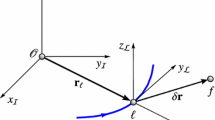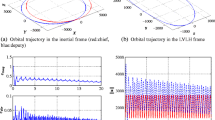Abstract
Encke's method as modified by Potter to increase the accuracy of orbit computations of gravitationally interacting bodies is applied to the problem of relative motion of non-interacting space vehicles. This technique is then combined with a simple transformation of the independent variable to arrive at a system of equations from which the relative motion may be determined with increased precision.
Similar content being viewed by others
References
Battin, R.: 1965,Astronomical Guidance, McGraw Hill Co., New York, p. 216.
Eades, J. B.: 1973–75,Analytical Mechanics Associates Reports.
Eggleston, J. M.: 1965,NASA-TN D-1029.
Encke, J. F.: 1857,Berliner Jahrbuch.
Euler, L.: 1772,Theoria Motuum Lunae, Acad. Petropoli.
Nacozy, P.: 1973,Bull. of the Am. Astronomical Soc., Vol. 5, No. 1.
Stiefel, E. and Scheifele, G.: 1971,Linear and Regular Celestial Mechanics, Springer Publishing Company, New York.
Sundman, K.: 1912,Acta Math. 36, 105.
Szebehely, V.: 1976,Celestial Mechanics, in print.
Velez, C. E.: 1974,Celestial Mechanics, Vol. 10, No. 4, p. 405.
Author information
Authors and Affiliations
Rights and permissions
About this article
Cite this article
Nacozy, P., Szebehely, V. The computation of relative motion with increased precision. Celestial Mechanics 13, 449–453 (1976). https://doi.org/10.1007/BF01229097
Received:
Issue Date:
DOI: https://doi.org/10.1007/BF01229097




